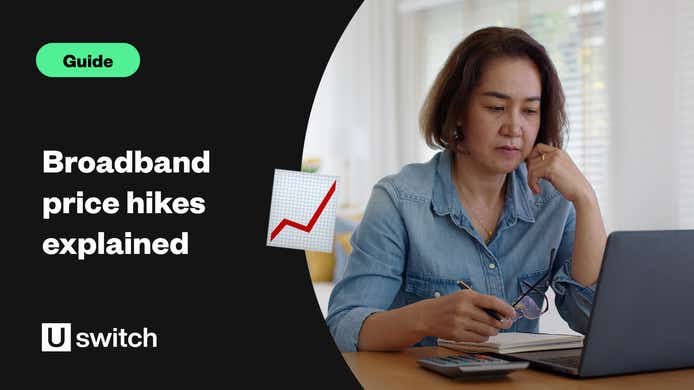Has your broadband bill gone up? Switch and save if you're out of contract.
If your contract term has ended, you're free to find a better deal right away. Browse a range of broadband offers with Uswitch:
Still in-contract?
Get the latest advice on finding a great broadband deal from Uswitch, so you can switch confidently when your contract ends.
UK provider EE increased its broadband prices by 7.9% for almost all customers on 31st March 2024.
This figure is linked to the 4% Consumer Price Index inflation rate announced in January 2024, and it applies to both people who are in-contract and out of contract with EE.
But crucially, if you are in the middle of your contract, you aren’t allowed to leave your contract early as a result of this price rise without paying a penalty charge. So, unless you’re on the EE Basics social tariff, you will likely have seen your April 2024 bill increase by 7.9%.
Keep in mind too - any customer who takes out an EE broadband contract from 10 April 2024 will instead be subject to a fixed annual price increase of £3 per month, rather than an inflation-linked one. This is because Ofcom has introduced a ban on inflation-based price increases from 2025.
Why does EE increase prices, even for mid-contract customers? And can you do anything to avoid the price increase altogether? Find out in our guide.
How much was EE’s 2024 broadband price increase?
EE's annual mid-contract price increase was 7.9%.
Broadband providers have historically increased their prices in line with the inflation rate each year, plus their own amount of about 4%. This is mainly so they can keep up with rising prices in their industry.
However, as previously mentioned, this will change for all future new EE customers as its price rises have changed to a flat £3 per month each year.
Given the huge rise in inflation in the last year, 2023’s price increase stung a lot harder — at a time when monthly costs for other services were already very high. So even though inflation has gone down and this year's price rise is smaller, it's a second yearly price rise for many EE customers who are on one of its two-year contracts.
Here’s how a 7.9% price increase could change your monthly broadband bill:
| Current monthly cost | Increase amount (7.9%) | Annual extra cost |
|---|---|---|
| £20 | £1.58 | £18.96 |
| £30 | £2.37 | £28.44 |
| £40 | £3.16 | £37.92 |
| £50 | £3.95 | £47.40 |
| £75 | £5.93 | £71.16 |
If you'd like to know how much all broadband providers have increased prices by this year, take a look at our in-depth guide.
Which EE customers are affected?
Almost every EE customer has been affected by its 31 March 2024 price increase.
EE mentions in its terms and conditions - and in a one-pager of charges you’ll be sent when you sign up - that it will increase prices each year. So unfortunately, you would have accepted these terms when you took out your last contract with the provider.
The only named customers that aren’t affected by the 2024 price increase are social tariff customers using EE Basics.
Compare our best broadband deals
Search on Uswitch to find the right broadband package for you.
What can EE customers do when their prices increase?
Unfortunately, if you’re currently in-contract with EE, you won’t be able to leave your contract early without paying an early exit fee. This is because you would have 'agreed' to EE’s terms & conditions when you signed up for your current service, as it should display this information in the sign-up documentation.
So even though the increase rate was much larger than in previous years, you will unfortunately still have to pay the extra amount. And if you want to cancel your contract, you’ll need to pay out the rest of your contract in early exit fees.
How to cancel EE for free - you might be out of contract
However, this all changes if you’re out of contract. If your minimum term with EE has finished, you are well within your rights to switch to another provider straight away, without any charge.
In this case, you are likely paying more than you need to for your service already. EE would have raised your prices to an out-of-contract rate after your contract ended, which could have been an even higher increase than this one.
But there’s good news: this also means you can switch to a better broadband deal at just 30 days’ notice. So, if you want to avoid both this price rise and its out-of-contract prices, you can compare deals with Uswitch right away.
Broadband postcode checker
See what internet speeds are available and compare prices for any postcode in the UK.
Why is EE increasing broadband prices?
EE increases its prices annually for the same reason most other providers do. These annual price rises are said to cover two things: rising business expenses and network upgrades.
Ofcom recently announced that it'd be reviewing how telecoms price rises currently work, and pushing for providers to detach their price rises from the inflation rate. This would help customers see, in pounds and pence, any price rises they should expect in the duration of their contract.
The regulator also wants customers to be able to leave their contract for free if their provider increases their price mid-contract. This will let you look elsewhere if your bill is increased to an amount they're not happy with. However, any ruling that comes out of this proposal will likely take effect from 2025 onwards.
In the meantime, if you want to find out which broadband provider is best for your needs, take a look at our in-depth provider reviews.
Uswitch broadband provider reviews
Read our expert reviews of all of the UK's biggest broadband providers.
How to contact EE
If you’d like to reach out to EE as a broadband customer, there are lots of ways you can do this. You can contact them to find out more about how this year’s price increase will affect you, or even attempt to negotiate a better deal with them.
Phone: Number: 0800 956 6000 | Opening hours: Monday-Friday, 8am-9pm and Saturday-Sunday, 8am-8pm
Website: Log into your account on My EE Broadband
Twitter: Get a response from the EE customer services team on Twitter
If you’re looking to reduce the amount you spend on your next broadband package, take a look at our range of cheap broadband deals.
Find cheap broadband deals
Browse our selection of low-cost broadband deals if you want to save money on your next broadband service.
EE broadband price rise FAQs
Can I negotiate my broadband prices with EE?
You might be able to negotiate a better deal with EE, but you’re not guaranteed to get a better deal by haggling. However, some customers have had success recently in the wake of this year’s price rise news.
So, while you’re weighing up your options, it’s always worth discussing it with their customer services team.
Can I cancel my EE contract at any time?
If you’re currently in a contract with EE, you won’t be able to cancel your contract for free. If you want to cancel it with several months still left, you will likely have to pay the remainder of your contract in one lump sum, which can be expensive.
However, if your contract has come to an end, you’re free to cancel and switch to a better deal whenever suits you. You’ll just have to give the provider 30 days’ notice to end your current service.




